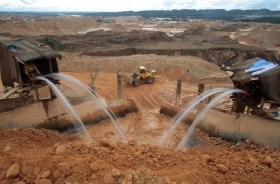Profits from illegal mining in Peru are higher than those of cocaine trafficking, according to a consulting firm. In some ways, however, this is a sensationalist comparison, intended more to attract attention than to accurately describe the problem.
Peru’s illegal mining exports were worth an estimated $1.79 billion in 2011, compared to the $1.2 billion-worth of cocaine trafficked through the country that year, according to analyst Elmer Cuba of Peru-based consultancy firm Macroconsult. This means illicit gold exports accounted for 22 percent of Peru’s total exports of the metal in 2011.
The estimate for the total worth of Peru’s exported cocaine is Macroconsult’s calculation, appearing in a book on the country’s drug trade published last year.
According to the US government, Peru has now surpassed Colombia as the world’s largest producer of pure cocaine. The growing drug trade has helped fuel the resurgence of rebel group the Shining Path in remote parts of the country.
And like its Andean neighbors Colombia and Ecuador, Peru is facing another huge problem in its growing illegal mining sector. There have been attempts in Peru to link the informal mining trade to organized crime, but evidence for this is sketchy.
InSight Crime Analysis
Estimates on the size of any illegal economy are inherently unreliable. Macroconsult’s numbers provide a useful idea of how big Peru’s informal mining trade and drug trade have become, but these cannot necessarily be used to guide policy decisions.
The figures imply that informal mining has become just as serious a problem for Peru as drug trafficking, but in security terms this is not the case. Informal mining does share several similarities with the drug economy; both need a base of impoverished producers — coca growers or artisanal miners — in order to flourish. However, this doesn’t mean informal mining should be treated as a security issue. In Peru, informal mining is still more of an environmental, economic, and social problem than an issue of organized crime. So far, there is more evidence of criminal groups’ involvement in illegal timber exports than gold.
Macroconsult analyst Cuba also pointed out that the Madre de Dios region, Peru’s gold mining heartland, sees the largest illegal gold exports, but was not counted in the study. It was once a major coca-producing area, but due to pressure from the government many coca growers had to find alternative livelihoods, such as cacao farming. The decline of the coca economy could also explain why informal mining has grown so dramatically in Madre de Dios in recent years, as communities looked for other ways to sustain themselves economically. A similar phenomenon has taken place in some parts of Colombia, helped fuel the growth of informal mining there.

